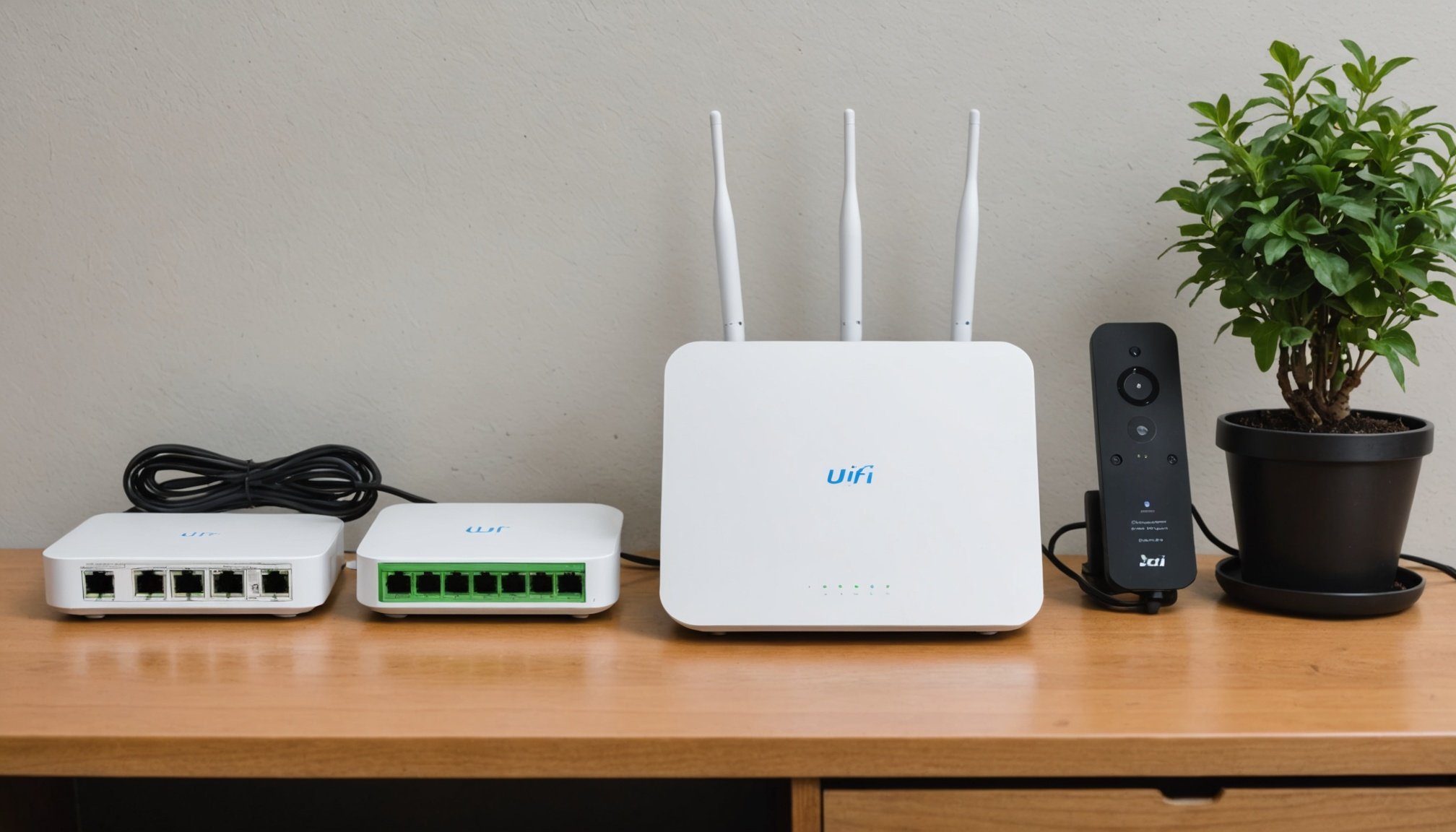Comprehensive Setup Guide for Ubiquiti UniFi Switch 24 PoE
When setting up a Ubiquiti network, it’s vital to have the right equipment and tools on hand. For the UniFi Switch configuration, you will need the UniFi Switch 24 PoE, Ethernet cables, a computer with the UniFi Network Application installed, and access points. Ensure that your UniFi Switch has power and network connectivity to begin the process.
To start the PoE network setup, mount the UniFi Switch securely in a rack using compatible screws and brackets. Once the switch is in place, connect it to your network using an Ethernet cable plugged into any of its standard ports. Then, power it on. Your computer should be on the same network to access the switch.
Also to discover : Effortlessly Create a Multi-Room Audio Experience with Apple HomePod Mini and Synology NAS: A Step-by-Step Guide!
Next, open the UniFi Network Application on your computer and adopt the UniFi Switch 24 PoE. Follow the application’s instructions to configure network settings and assign IP addresses.
To connect access points, plug them into the PoE ports on the switch. The power delivery feature ensures access points receive both power and data through single Ethernet cables, simplifying your setup process. Verify that each access point is operational using the UniFi Network Application. Regularly check for software updates to ensure optimal performance and security.
In the same genre : Maximizing Remote Work Efficiency: A Guide to Setting Up Your HP Elite Dragonfly with Multiple External Displays
Best Practices for Configuring Access Points
Configuring access points to their full potential involves a few best practices to ensure efficiency and performance within your network.
Selecting Optimal Locations for Access Points
Selecting the right locations for access points is crucial in WiFi optimization. Aim to place access points centrally within the area they will serve, ensuring that there are no significant obstructions that could hinder the signal. Avoid placing access points near metal objects or thick walls, as these can degrade WiFi performance. The goal is to provide consistent coverage across all required spaces, minimizing any blind spots.
Configuring SSIDs and Security Settings
Proper SSID configuration and robust security settings are paramount. Use distinct SSIDs for different user groups or purposes, such as employee access and guest networks. Ensure your network is secured with the latest encryption standards, such as WPA3, to protect against unauthorized access. Disabling the broadcast of SSIDs can also enhance security.
Utilizing Band Steering and Mesh Networking
Leveraging band steering can improve client distribution between the 2.4 GHz and 5 GHz bands, optimizing performance. Implementing mesh networking allows for seamless roaming capabilities, ensuring devices remain connected without drops when moving through different areas. This method can significantly enhance user experience by maintaining optimal signal coverage and smooth transitions between access points.
Network Performance Optimization Techniques
Enhancing your network’s capabilities through network optimization and performance tuning can vastly improve efficiency and speed. Regular firmware updates play a crucial role as they often contain bug fixes and performance improvements. Ensuring that your system is always running the latest version can help you avoid unnecessary slowdowns and potential security vulnerabilities.
Routine network health checks are fundamental in identifying and resolving issues that may impact performance. These health checks often involve monitoring various parameters, including error rates and latency, providing insights into areas needing improvement.
Monitoring bandwidth and traffic usage is another critical aspect of maintaining optimal network performance. Tools within the UniFi system allow you to gain visibility over devices and applications consuming the most bandwidth. This knowledge can help in balancing loads more effectively and prioritizing critical traffic to enhance efficiency.
For those seeking even more refined control over their network, exploring advanced settings can yield significant benefits. These settings, found in your network’s control hub, often include options to prioritize specific types of traffic, manage Quality of Service (QoS), and adjust channel widths. By carefully tuning these settings, you can achieve a finely balanced, high-performance network environment.
Troubleshooting Common Network Issues
Navigating network issues can be daunting, but understanding and addressing common problems can simplify the process significantly. Troubleshooting efficiently requires grasping concepts like network connectivity, Power over Ethernet (PoE) and latency.
Identifying Connectivity Issues
Connectivity problems can arise from misconfiguration or hardware failures. To effectively tackle these, verify network settings and ensure cables are securely connected. Check router and switch settings for errors, as simple misconfigurations often lead to connectivity disruptions. If you’re using Ubiquiti devices, their intuitive interface can guide you through potential missteps, making network troubleshooting straightforward.
Resolving PoE Problems
Power over Ethernet issues frequently surface when network devices aren’t receiving adequate power. Inspect PoE injectors and switches to confirm they supply the necessary wattage. It’s essential to use compatible devices, as incompatible equipment can inhibit power transmission, causing failures. Seek assistance from Ubiquiti support for brand-specific queries, guaranteeing precise solutions.
Addressing Latency and Interference
Latency and interference degrade network performance, urging swift action. Use network analyzers like Wireshark to pinpoint latency causes. Ensure proper channel selection in wireless networks to prevent interference. Signal strength testing tools are invaluable for detecting obstructions reducing efficiency. Adjust settings accordingly to boost performance.
Ensuring Network Security and Management
In today’s digital age, ensuring network security is paramount. Implementing robust security protocols is crucial to protect digital assets. Begin by securing the network devices using UniFi security features. These offer advanced settings such as WPA3 encryption, firewall configuration, and intrusion detection systems, which help shield against potential threats.
Monitoring your network continuously is another key aspect. By utilizing the UniFi controller software, you can efficiently oversee the network environment. This tool enables administrators to monitor devices and user access, ensuring security compliance. Users can track connected devices, manage bandwidth allocations, and configure alert systems to detect unusual activities.
Here are some management tips to enhance your security measures:
- Regularly update software to protect against vulnerabilities.
- Schedule routine audits to identify and patch security gaps.
- Enable multi-factor authentication to add an extra layer of protection.
By incorporating these practices, you ensure not only a secure network but also one that operates seamlessly. The combination of robust protocols and efficient management tools fortifies the network against external and internal threats, offering peace of mind and enhanced operational capability. Through endeavoring to uphold these standards, your network security stands as a robust barrier against potential cyber threats.
Visual Aids and Diagrams for Clarity
In the realm of setting up network systems, visual aids and diagrams offer indispensable support, ensuring understanding and effective deployment.
Setup Diagrams for Switch and Access Points
Creating effective network diagrams can transform complex setups into digestible visuals. When configuring a switch or access point, it’s beneficial to utilize setup visuals that illustrate the positioning and connections clearly. These diagrams depict the flow of data, helping identify potential problem areas in communication or coverage. By using straightforward illustrations, both novices and experts can ensure that hardware connections are optimized for maximum performance.
Infographics on Configuration Best Practices
Infographics play a vital role in conveying best practices for network configuration. Simplifying information into visual formats allows users to grasp essential concepts quickly and apply them efficiently. Elements like configuration images highlight critical settings and suggest optimal configurations, reducing the potential for human error. Incorporating these graphics into guides or manuals enriches the reader’s ability to follow recommended protocols.
Flowcharts for Troubleshooting Steps
When network issues arise, clear flowcharts guide users through troubleshooting steps efficiently. These illustrative representations break down each intervention clearly and linearly. By visualizing the process, users can easily identify where they are in diagnosis, aligning actions with resolutions. Simplified guides support timely restoration of connectivity, enhancing productivity through visual breakdowns of troubleshooting processes.











